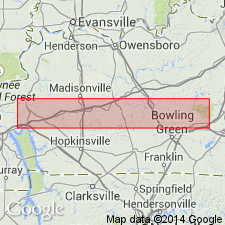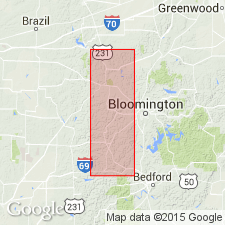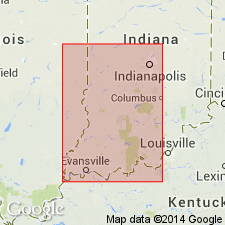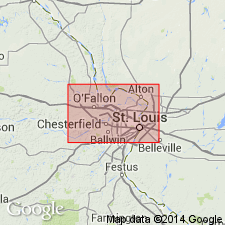
- Usage in publication:
-
- Levias limestone member
- Modifications:
-
- Named
- Dominant lithology:
-
- Limestone
- AAPG geologic province:
-
- Illinois basin
Summary:
Name Levias, with type locality just east of town of that name in Crittenden Co., KY, is now proposed for uppermost member of the Ste. Genevieve, between Rosiclare sandstone below and Renault formation above in western KY and adjacent IL. Replaces "Lower Ohara" of Butts and Ulrich. Ohara, as originally defined should not be considered a stratigraphic unit because it transgresses an important unconformity. The part that has been termed "Upper Ohara" is equivalent to the Renault of IL. Name Ohara is rejected as it has been made useless by nearly 30 yrs of misinterpretation.
Source: GNU records (USGS DDS-6; Reston GNULEX).

- Usage in publication:
-
- Levias Member
- Modifications:
-
- Revised
- AAPG geologic province:
-
- Illinois basin
Summary:
Indian Creek Limestone Beds is introduced here as a new name for the lower half of the Levias Member of the Ste. Genevieve Formation in Lawrence and Monroe Cos., south-central IN. Unit is composed of lithographic, silty, thinly and evenly bedded limestone. Top is 28 ft below the Bryantsville Breccia Bed. Beds are 27.5 ft thick and conformably overlie the Rosiclare Member.
Source: GNU records (USGS DDS-6; Reston GNULEX).

- Usage in publication:
-
- Levias Member
- Modifications:
-
- Areal extent
- AAPG geologic province:
-
- Illinois basin
Summary:
Levias and Spar Mountain Members of Ste. Genevieve Limestone are no longer used in Indiana. Usage of the Ste. Genevieve of the Blue River Group in Indiana is here revised. In the subsurface, unit is divided into (ascending) Fredonia, Karnak, and Joppa Members, which are basically equivalent to members of the same name in IL. This nomenclature replaces that of Shaver and others (1986) as the IN State usage. In outcrop, Joppa is replaced by rocks typical of upper Karnak. Uppermost rocks of the Ste. Genevieve on the surface and in the very shallow subsurface are assigned to the Bryantsville Breccia Bed of the Karnak Member. Bryantsville of previous usage marked the top of the Levias Member. [Indian Creek Limestone Beds not discussed.]
Source: GNU records (USGS DDS-6; Reston GNULEX).

- Usage in publication:
-
- Levias Member*
- Modifications:
-
- Overview
- AAPG geologic province:
-
- Illinois basin
Summary:
Upper Mississippian (Meramecian and Chesterian) Levias Member of Renault Limestone is mapped undivided with rest of Renault Limestone, which is in turn mapped undivided with Aux Vases Sandstone and Yankeetown Sandstone. Not found in MO.
Source: GNU records (USGS DDS-6; Reston GNULEX).
For more information, please contact Nancy Stamm, Geologic Names Committee Secretary.
Asterisk (*) indicates published by U.S. Geological Survey authors.
"No current usage" (†) implies that a name has been abandoned or has fallen into disuse. Former usage and, if known, replacement name given in parentheses ( ).
Slash (/) indicates name conflicts with nomenclatural guidelines (CSN, 1933; ACSN, 1961, 1970; NACSN, 1983, 2005, 2021). May be explained within brackets ([ ]).

